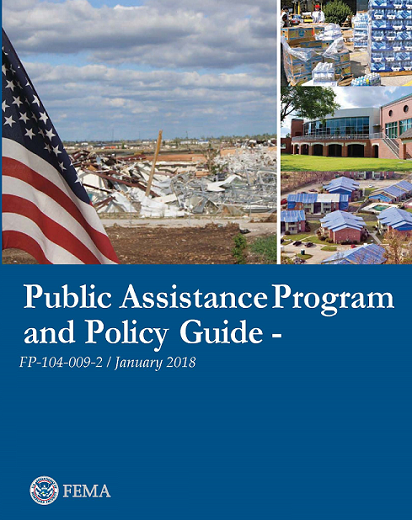TITLE 42. THE PUBLIC HEALTH AND WELFARE
CHAPTER 68--DISASTER
RELIEF
SUBCHAPTER I--FINDINGS, DECLARATIONS, AND DEFINITIONS
{101} 5121. Congressional
findings and declarations
(a) The Congress hereby finds and declares that--
(1) because disasters often cause loss of life, human
suffering, loss of income, and property loss and damage; and
(2) because disasters often disrupt the normal functioning of
governments and communities, and adversely affect individuals and families
with great severity; special measures, designed to assist the efforts
of the affected States in expediting the rendering of aid, assistance,
and emergency services, and the reconstruction and rehabilitation of devastated
areas, are necessary.
(b) It is the intent of the Congress, by this chapter, to provide an
orderly and continuing means of assistance by the Federal Government to
State and local governments in carrying out their responsibilities to alleviate
the suffering and damage which result from such disasters
by--
(1) revising and broadening the scope of existing disaster
relief programs;
(2) encouraging the development of comprehensive disaster preparedness
and assistance plans, programs, capabilities, and organizations by the
States and by local governments;
(3) achieving greater coordination and responsiveness of disaster
preparedness and relief programs;
(4) encouraging individuals, States, and local governments to
protect themselves by obtaining insurance coverage to supplement or replace
governmental assistance;
(5) encouraging hazard mitigation measures to reduce losses
from disasters, including development of land use and construction regulations;
and
(6) providing Federal assistance programs for both public and
private losses sustained in disasters
(7) Repealed. Pub.L. 100-707, Title I, 103(a)(1),
Nov. 23, 1988, 102 Stat. 4689
{102}
5122. Definitions As used in this chapter--
(1) Emergency--"Emergency"
means any occasion or instance for which,
in the determination of the President, Federal assistance
is needed to supplement State and local efforts and capabilities to save
lives and to protect property and public health and safety, or to lessen
or avert the threat of a catastrophe in any part of the United States.
(2) Major disaster--"Major
disaster" means any natural catastrophe (including any hurricane, tornado,
storm, high water, winddriven water, tidal wave, tsunami, earthquake, volcanic
eruption, landslide, mudslide, snowstorm, or drought), or, regardless
of cause, any fire, flood, or explosion, in any part of the United States,
which in the determination of the President causes damage of sufficient
severity and magnitude to warrant major disaster assistance under this
chapter to supplement the efforts and available resources of States, local
governments, and disaster relief organizations in alleviating the damage,
loss, hardship, or suffering caused thereby.
(3) "United States" means
the fifty States, the District of Columbia, Puerto Rico, the Virgin Islands,
Guam, American Samoa, the Northern Mariana Islands, and the Trust Territory
of th Pacific Islands.
(4) "State" means any State
of the United States, the District of Columbia, Puerto Rico, the Virgin
Islands, Guam, American Samoa, the Northern Mariana Islands, or the Trust
Territory of the Pacific Islands.
(5) "Governor" means the
chief executive of any State.
(6) "Local government" means
(A) any county, city, village, town, district, or other political
subdivision of any State, any Indian tribe or authorized tribal organization,
or Alaska Native village or organization, and
(B) includes any rural community or unincorporated town or village
or any other public entity for which an application for assistance is made
by a State or political subdivision thereof.
(7) "Federal agency" means
any department, independent establishment, Government corporation, or other
agency of the executive branch of the Federal Government, including the
United States Postal Service, but shall not include the American National
Red Cross.
(8) Public facility--"Public
facility" means the following facilities owned by a State or local government:
(A) Any flood control, navigation, irrigation, reclamation,
public power, sewage treatment and collection, water supply and distribution,
watershed development, or airport facility.
(B) Any non-Federal-aid street, road, or highway.
(C) Any other public building, structure, or system, including
those used for educational, recreational, or cultural purposes.
(D) Any park.
(9) Private nonprofit facility--"Private
nonprofit facility" means private nonprofit educational, utility, emergency,
medical, rehabilitational, and temporary or permanent custodial care facilities
(including those for the aged and disabled), other private nonprofit facilities
which provide essential services of a governmental nature to the general
public, and facilities on Indian reservations as defined by the President.
The FEMA Public Assistance Program and Policy
Guide (PAPPG) is FEMA's Public Assistance Grant Bible.

The 2018 PAPPG (V3.0) is effective for
all emergencies and major disasters declared on or after
August 23, 2017. It supersedes the 2017 PAPPG (V2.0) which
is effective for all emergencies and major disasters
declared between April 1, 2017 and August 22, 2017.
Proceeds from the sale of this book support the Disaster
Center
|
DisasterCenter.com is happy to make the
Federal Emergency Management Administration's (FEMA)
Public Assistance Program and Policy Guide (PAPPG) V 3.0
available in a print format.
FEMA Public Assistance (PA) provides
grants to jurisdictions and certain non-profits for the
costs of emergency response and for damages to permanent
facilities damaged as a result of events that qualify for
Presidential Disaster Declarations.
In terms of dollar amounts, FEMA's
Public Assistance Program is the largest grant program
that FEMA operates.
FEMA PA can assist with local and State
governments? emergency response efforts and in the
restoration of public infrastructure after Presidential
disaster declarations in the United States.
|
